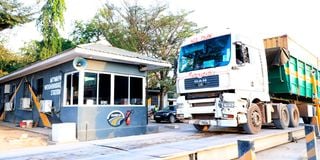KPA wants weighbridges reduced to cut red tape and curb delays in port

Trucks pass through the Mtwapa Weighbridge Station in Kilifi County in this photo taken on February 9, 2023. The Kenya Ports Authority (KPA) has said delays at the Mombasa port are compounded by poor inland distribution infrastructure and non-tariff barriers such as inefficient weighbridges, which translates to high costs of doing business.
The Kenya Ports Authority (KPA) has said delays at the Mombasa port are compounded by poor inland distribution infrastructure and non-tariff barriers such as inefficient weighbridges, which translates to high costs of doing business.
Yesterday, KPA Managing Director William Kipkemboi Ruto recommended to a parliamentary committee the reduction of weighbridges along the Northern Corridor from nine to three.
He blamed the many weighbridges for causing unnecessary traffic gridlocks and inconveniencing other road users on the corridor’s Mombasa-Malaba section.
Mr Ruto said the matter has featured prominently in meetings between the KPA management and Transport Cabinet Secretary Kipchumba Murkomen.
The MD said all custom-sealed containerised transit cargo should only be weighed at the first weighbridge encountered after leaving the port or point of loading and at the last weighbridge at the point of exit from the border.
“Weighing and documenting trucks at the port and tracking it using the Regional Electronic Cargo Tracking System will not only reduce truck turnaround time but also reduce cases of corruption and traffic snarl-ups along the highway,” Mr Ruto said.
He spoke during a meeting with the National Assembly Regional Integration Committee, which visited the port and Mariakani weighbridge during a fact-finding mission on reasons behind increasing bottlenecks along the highway and delays in delivering cargo.
Mr Ruto said vigilance should be improved to replace weighbridges.
“Once a truck is checked and certified with valid documents, it should be allowed to proceed to the next border exit points at Malaba, Namanga or Busia unless the seal is tampered. Bureaucracies at weighbridges discourage many transporters from using the port of Mombasa but once we adopt technology we can attract more volumes as cargo will move faster than before,” he said.
The Northern Corridor starts at the port of Mombasa and is a key trade route with a length of 1,700 kilometres that serves Kenya, Uganda, Rwanda, Burundi and Eastern DRC.
There are nine weighbridges on the national road network with only Mariakani, Athi River, Gilgil and Webuye having high-speed weigh motion machines and multi-deck scales while others are manually operated.
Harassment claims
Committee’s chairperson David Ochieng questioned why traders have been complaining of being harassed by different government agencies despite only a few being allowed to operate at the port.
In response, Mr Ruto said only four agencies; KPA, Kenya Revenue Authority, Kenya Plant Health Inspectorate Service and Kenya Bureau of Standards are allowed to directly get in touch with cargo.
“Previously, we had 27 agencies handling cargo at the port before it was released but we have reduced the number to four, which is a big plus in reducing cargo dwell time at the port. Other government agencies are only operating outside the port and we have no control over them since they are legally required to,” said the MD.
During the meeting, Mr Ruto revealed that KPA is working with Mombasa County to construct a cargo marshalling yard and also to construct a dry port in Taveta for onward cargo to Northern Tanzania.
“Plans are at an advanced stage to have Mombasa marshalling yard as we wait for the connection of railway line from Voi to Taveta before we construct a cargo handling yard in Taveta border,” he said.
The KPA management has in the past been accused of doing little to reduce inefficiencies and attract more volumes at the port of Mombasa, with the port of Dar es Salaam in Tanzania taking advantage to increase its market share at the expense of Kenya.





